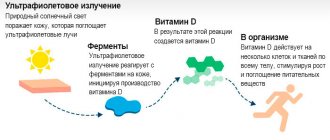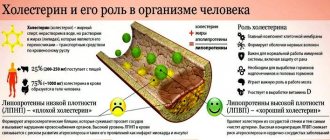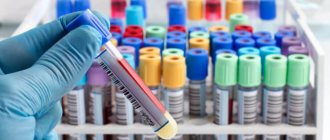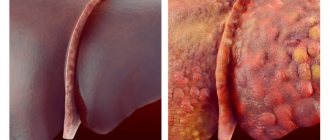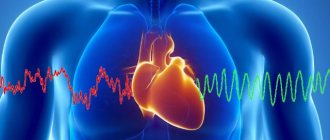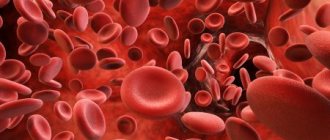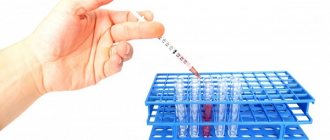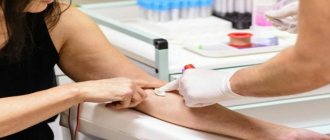Throughout a person’s life, all his organs and systems function without breaks or days off. To check the condition of the body, it is necessary to periodically undergo a medical examination, including laboratory diagnostic methods. The kidneys carry out a very serious daily load in the human body - they remove the end products of metabolic processes: nitrogenous waste (called “urea”), metabolites of proteins, uric and nucleic acids.
It is possible to assess the quality of the functional activity of the entire urinary system using a biochemical analysis, which allows one to determine the concentration of creatinine in the peripheral blood. A metabolite of the creatine-phosphate reaction (the end product of amino acid-protein metabolism) is formed in the tissues of the muscular system and is released into the circulating blood.
For the human body, this substance is very important due to its participation in muscle energy metabolism. After the beneficial effect of creatine phosphate is realized, it is converted into creatinine, which is easily removed by the kidneys along with urine. When this compound accumulates excessively in the human body, functional disorders begin. This phenomenon leads to toxic damage to the cells of its tissues, a change in the normal acid-base balance of biological fluids and metabolism in organs.
A significant excess of normal parameters requires the timely use of creatinine-reducing agents. Otherwise, its high level leads to the development of serious pathological processes in the brain, circulatory and respiratory systems, which can result in death.
A decrease in the amount of creatinine is observed under the influence of various factors - fasting, decreased muscle mass, pregnancy, the use of corticosteroid drugs, the presence of type I diabetes mellitus or chronic renal failure (CKD). Low creatinine in the circulating blood is often caused by puberty, exhaustion of the body, amputation of limbs, and partial or complete rejection of products of animal origin.
In this article, we want to provide our readers with detailed information about when to check the concentration of creatinine in the blood, what is normal, the need to eliminate the cause of its decrease and ways to increase the level of this compound.
When is the analysis performed?
The referral is issued by a general practitioner, nephrologist, infectious disease specialist, gynecologist or endocrinologist. Indications for analysis:
- signs of disease of the urinary system: change in the color of urine, difficulty urinating, pain or cramping, persistently high blood pressure, pain in the lumbar region, swelling, insomnia, weakness and poor appetite;
- the need for hemodialysis and evaluation of its effectiveness;
- control over the effectiveness of treatment methods for kidney pathologies;
- identification of complications when taking nephrotoxic drugs;
- advanced diagnostics of skeletal muscle diseases;
- severe dehydration of the body;
- preparatory procedures before computed tomography.
Venous blood is collected for the study.
Creatinine: children's and adult indicators
Main article: Tables of blood creatinine norms in women and men
The average concentration of creatinine in the blood is constant and does not change throughout the day. This is explained by the fact that a person’s muscle mass cannot sharply increase or decrease. Slight increases in the indicator are typical for high physical activity. However, this excess is within normal values or at their upper limit.
The normal level of creatinine in children depends on age. Ranges of acceptable values by age:
- the first month of a newborn baby’s life – from 20 to 77 µmol/l;
- first year – from 12 to 35 µmol/l;
- up to 3 years – from 20 to 37 µmol/l;
- 3 – 5 years – from 25 to µmol/l;
- 5 – 7 years – from 30 to 52 µmol/l;
- 7 – 10 years – 36 – 57 µmol/l;
- period of puberty 10 – 15 years – from 35 to 78 µmol/l.
It is not difficult to grasp a simple relationship: the older the child and the heavier his weight, the more creatinine is released from muscle tissue. Accordingly, the norm indicators also increase.
The norm of creatinine in men is from 80 to 115 µmol/l, in women it is slightly lower – 53-97 µmol/l. Women eat less meat containing nitrogenous metabolites. The percentage of muscle tissue in the body is also lower in women. Therefore, lower creatinine in the blood of women compared to men is a variant of the physiological norm.
Elevated creatinine – what to do?
If blood biochemistry reveals an increased creatinine level, first of all, you should not take any independent action. In this case, consultation with a specialist and a thorough and comprehensive examination are required. Only after this can a comprehensive list of recommendations for reducing creatinine levels be developed. If the deviation from the norm is insignificant and there are no alarming symptoms, actions usually boil down to adjusting your diet and lifestyle. If the creatinine level significantly exceeds normal levels, taking medications is inevitable. Usually in this case, medications are prescribed that normalize the process of protein breakdown.
What are the causes of low creatinine in the blood?
The causes of low creatinine in the blood can be divided into female and common to both sexes.
Ladies should pay special attention to this indicator during pregnancy. Because while carrying a baby, the urinary system works in an enhanced mode. There is an increased excretion of a nitrogenous metabolite in the urine. In parallel with this, there is an increase in the total volume of blood in the woman’s body.
Important: low creatine in the blood of women during pregnancy is a variant of the physiological norm (especially in the first and second trimester).
If a woman experiences poor weight gain, she is advised to reconsider her diet and menu. This is of particular importance for ladies who adhere to a vegetarian diet.
For men involved in sports, low creatinine levels are not typical. Especially when using various doping additives, which contain the end product of creatine phosphate decomposition. They are usually characterized by a state of excess amount of the substance in the blood.
Creatinine in the blood is reduced if a person is hungry or lacks fluid in the body. Among the common reasons, the following should also be highlighted:
- severe weight loss and decrease in the percentage of muscle tissue;
- long-term protein-free diet;
- use of glucocorticosteroids;
- myodystrophy.
Separately, the situation should be identified when creatinine is reduced as a result of taking medications. Among them: antibacterial agents, diuretics, sedatives, sleeping pills and steroid drugs. While taking these medications, the patient may receive false-negative laboratory test results. After completing the course of treatment, the test should be repeated 5 to 7 days later to confirm normal creatinine levels in the blood.
Read further: What does an increase in creatinine in the blood of an adult indicate?
Physiological reasons for decreased creatinine levels
It has been noted that creatinine is reduced in people who have been without physical activity for a long time. For example, if it is necessary to comply with bed rest. In this case, the muscles do not require a large amount of energy. The breakdown reaction of creatine phosphate decreases and the amount of creatinine decreases proportionally.
This deviation is temporary. The indicator returns to normal levels when the normal level of physical activity is restored.
A similar situation is typical for older people. Along with a decrease in physical activity, the percentage of muscle tissue in the body decreases. What should be taken into account when identifying the severity of diseases of the urinary system for older people.
Symptoms of elevated creatinine
As a rule, an increase in creatinine in the blood leads to the appearance of a classic picture of kidney damage in a person. These include:
- pain in the lower back and lower back;
- impaired diuresis (urine excretion) - this can be either a complete absence of urine (anuria) or the release of 2 liters or more (polyuria);
- hypertensive syndrome - increased blood pressure;
- swelling;
- urinalysis reveals protein and red blood cells.
If the patient's creatinine levels increase, and clearance (this is an indicator of the kidneys' ability to filter a certain volume of blood in one minute) decreases, then increasing fatigue, nausea, loss of appetite, anemia, and shortness of breath are observed. In severe cases, there may be confusion or loss of consciousness and seizures.
Ways to increase creatinine levels
At the first stage, a person is recommended to choose a special diet that will contain a high amount of muscle fibers. Consumption of meat, fish and other seafood is increasing. There is no complete alternative to the diet, so vegetarians should add at least fish dishes to the menu to maintain health.
In general, building muscle mass leads to a natural increase in the indicator to normal values. This is facilitated by:
- rational nutrition and physical activity;
- drinking water at least 2 liters per day;
- vitamins and mineral complexes, if necessary, to restore the lack of these substances.
Energy reserves are replenished by regulating sleep patterns. Prolonged lack of rest, exhaustion and fatigue contribute to the development of chronic depression and decreased performance. Against this background, the biochemical composition of the blood also changes. You should plan the amount of work for each day in such a way that you have at least 6 to 7 hours of sleep left.
Separately, we should highlight the situation when the concentration of creatinine falls against the background of diseases. In this case, an extended differential diagnosis is carried out, a final diagnosis is established and treatment is selected.
High level reasons
Why do creatinine and urea levels increase:
- kidney diseases, including renal failure of 1-2 degrees of severity;
- intoxication and poisoning of the body with liver damage and impairment of its function;
- inflammatory diseases, extensive burns and muscle injuries;
- acute arterial occlusion with the formation of gangrene;
- endocrine system disorders, thyrotoxicosis;
- purulent infections, causing intoxication;
- acute inflammatory diseases of the abdominal cavity;
- drug intoxication with impaired renal function;
- severe toxicosis during pregnancy;
- cardiovascular diseases, including heart failure.
These are the causes of pathological increases in urea and creatinine, and this means that treatment will begin with eliminating the source of the pathology. The analysis may show a slight deviation - physiological. The reasons for such a deviation are less dangerous, but also require examination of the excretory organs.
An increased level of urea and other elements of residual nitrogen by several units is a conditional norm, since it has a different meaning for different people. To find out exactly the cause, an additional test is prescribed after a few days, an ultrasound of the abdominal cavity, a study of the kidneys and thyroid gland. Repeated analysis is necessary, since the norm can vary depending on nutrition, physical activity, and psychological state.
Kidney diseases
Impaired functioning of the kidneys and excretory tracts is both the cause and consequence of a violation of the quantitative indicator of residual nitrogen. In renal failure, there will be a significant deviation, and this means that the function of the organ is severely impaired. The norm for men may be a deviation for women, so the analysis must be examined by an experienced specialist; it is impossible to decipher it on your own.
There are acute and chronic kidney failure. Increased residual nitrogen in the blood can tell about this and direct a specialist to the source of the deviation so that the treatment is effective.
The norm of biochemical analysis is not always reliable; in case of chronic renal failure, the results may deviate slightly. The doctor must take into account concomitant manifestations, including urination problems, drowsiness, dyspeptic disorders, and dizziness.
Treatment of renal failure is carried out comprehensively, in addition to mandatory medications and procedures, the patient is prescribed a diet and bad habits are eliminated.
How to take a creatinine test?
The research can be carried out in a state or private laboratory. Proper preparation is the key to accurate results.
Important: if red blood cells are destroyed during blood collection (the color of the blood in the test tube becomes dark brown), the analysis is canceled. Obtaining reliable laboratory analysis data in this case is impossible.
In order to reduce the risk of hemolysis (decomposition of red blood cells), the patient is recommended to drink large amounts of unsweetened water 2 to 3 hours before the visit to the laboratory. The study must be carried out on an empty stomach. Any sports are excluded 12 hours before, and smoking 30 minutes before.
Read further: How to reduce creatinine in the blood - treatment and diet
- about the author
- Recent publications
Yulia Martynovich (Peshkova)
Certified specialist, in 2014 she graduated with honors from the Orenburg State University with a degree in microbiologist. Graduate of the graduate school of the Federal State Budgetary Educational Institution of Higher Education Orenburg State Agrarian University. In 2015 At the Institute of Cellular and Intracellular Symbiosis of the Ural Branch of the Russian Academy of Sciences, she completed advanced training in the additional professional program “Bacteriology”. Laureate of the All-Russian competition for the best scientific work in the “Biological Sciences” category 2020. Author of many scientific publications. More details
Children and creatinine norm
Under the age of 18, creatinine levels do not differ between female and male populations. The average level is 20-80 µmol/liter. But as you grow older, the concentration of creatinine gradually changes according to the following pattern:
- Newborns have the same norm as adult patients, since when they are born, the child’s body experiences a serious load. Then this indicator decreases to a level of 30-35 µmol/liter (up to 1 year).
- At the age of 1-14 years, these indicators increase due to the intensive growth of the child. Therefore, the creatinine level should not be below 27 points.
- During adolescence and until the age of 18, hormonal changes occur in the female and male body. Thus, the norm among girls varies between 50-80 µmol/liter, and among boys – 60-95 µmol/liter.
